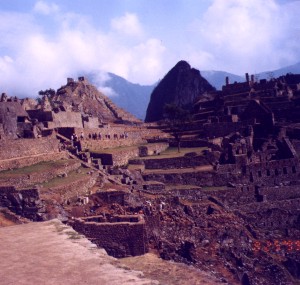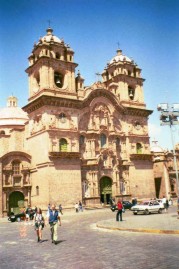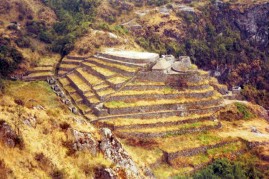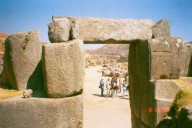
THE INCAS OF PERU
The geography and resultant weather of South America in part explains why the native Indians chose to live in the otherwise inhospitable mountains. The Andes Mountains run from north to south along the Western border of South America. These mountains are rugged and steep, with altitudes of up to 20,000 feet. Even in the tropical latitudes, some of these peaks remain snow covered throughout the year.
In the tropical latitudes, the prevailing winds are easterly. To the east of the Andes Mountains, tropical vegetation and jungles prevail, including much of Brazil. To the west of the mountains, including the Western portion of Peru, desert is predominant. The mountainous territory experiences a rainy season and dry season. It is likely that the mountainous climates provided the optimal conditions for agriculture, the basis for cultural development of the Inca and other native South American Indians.
The Inca Indians achieved the peak of their civilization around the 14th century. The Inca actually refers to the leader of the Indians. The government was dictatorial and totalitarian, with the government seat situated centrally in the mountainous city of Cusco. It is from this city that the Inca ruled. At its peak, the Empire extended almost the entire length of the Andes. Communication was accomplished along mountainous trails, with runners relaying messages which were represented by variably colored and numbered rows of string or beads.
Inca mythology believed that life originated in Lake Tittacca. They worship nature and believed that there were three levels of existence:
1. Underground-symbolized by the snake
2. On ground-symbolized by the puma [large cat]
3. Above ground-symbolized by the condor
The Inca believed in reincarnation. Ceremonial burials and occasional mummifications saw that the dead were prepared for the next world with clothing, food, and other items. Below is a burial site at Macchu Picchu. Note the three levels of stairs and the carefully fitting native and added rocks demarcating the crypt.
The Inca were fierce warriors and gained territory by conquering adjacent tribes and assimilating them into their own culture. Society was a heirarchy with regional officials, including tax collectors. Potatoes were a staple crop and the llama and guinea pig were sources of protein. Gold and precious metals were utilized for decorations by the ruling class and in the worship of the Inca gods, including the sun and the moon. The Inca were excellent astronomers and monuments and buildings which they erected in tribute to their gods, reflected a keen understanding of the seasons and of the movements of celestial bodies.
Most dramatic testimony to the civilization of the Inca is the intricate stone work. Terracing the mountains was essential to allow for agriculture, as flat land was needed to prevent erosion during the rainy season. Just outside of Cuzco is this circular agricultural terraced pit which was used to test the effect of temperature on various crops.
The Inca perfected retaining stone walls that have withstood centuries of assault, including earthquakes. Temples and the more important cities show examples of the finest detail. Large rocks are juxtaposed with perfectly fitting borders. The monuments left by the Incas rival the pyramids of Egypt. The best-known example of Inca workmanship is demonstrated by the city/Temple of Macchu Picchu [below].

In the early 16th century, the conquitadores of Spain were seeking their fortune in the New World. After the Aztecs of Mexico were conquered, Pizzarro traveled south into the territory of the Inca. There was the beginning of rivalry and revolt among the conquered tribes. When Pizzarro and his small group first met the Indian, there was no fighting. The natives were by habit submissive. The impression that these decorated and armed strangers on large powerful beasts [horses] made was one of awe. When fighting later broke out the Inca clubs [which were intended to kill through a blow to the head] were no match for the metal weapons and muskets of the horse mounted and shielded Spaniard.
In fact, the regional leader felt that he was unjustly excluded from being the ruler of the entire Empire. The deal was struck. The Spanish would aid the Inca regain the throne.
Cuzco was conquered by the Spanish. The Indians, over the next thirty years, were completely assimilated and made Christians. Several attempts by the Indians to revolt against the unfair treatment that they received at the hands of the ruling Spaniards were unsuccessful. For many of the poor mountain Indians, life has not changed much. Ninety percent of the population of Peru, for instance, is mestizo, a mixture of Spanish and Indian blood. This is in sharp contrast to the native North American Indians, which have a small residual population and very little, if any, assimilation. Many young Indians dress traditionally so the tourists can shoot a picture. Gifts or money are always appreciated.
An American tourist desiring to view the stone work that is testimony to the Inca civilization will
likely have to fly through Lima, the capital of Peru, and the city founded by Pizzarro. In its earliest
days, the city was quite remarkable. Some old mansions remain, but the city is victim to the
economy with roofless slums the rule, rather than the exception. A short flight SE brings one to
the historic city of Cuzco. The buildings are masonry with tiled roofs. The streets are cobblestone
with central drains. The inhabitants are poor, but not lazy. A market economy is quite active.
Many artistic items are for sale at bargain prices.
civilization will
likely have to fly through Lima, the capital of Peru, and the city founded by Pizzarro. In its earliest
days, the city was quite remarkable. Some old mansions remain, but the city is victim to the
economy with roofless slums the rule, rather than the exception. A short flight SE brings one to
the historic city of Cuzco. The buildings are masonry with tiled roofs. The streets are cobblestone
with central drains. The inhabitants are poor, but not lazy. A market economy is quite active.
Many artistic items are for sale at bargain prices.
When the Spaniards first entered this city, they confiscated the gold which adorned and decorated the buildings of the ruler. Very little of the original gold pieces remains, apparently having been melted and shipped to Spain. Even today, however, some of the original stone work forms the foundation of Spanish churches. Earthquakes which have struck, result in ruin of all but the Inca stone work.
Short distances from the historic city are major sites of Inca civilization. Terraces were built for
agriculture.
Temples were built for worship [right].
Towers and walls were built for protection and inhabitation. [below]
The Inca were such excellent stone workers, that many of the trails are paved with stone stairs.
The Inca Trail marks the path that the native Indians followed to travel from Cuzco to Macchu Picchu. This Trail is about 25 miles long and results in an ascent from about 9000 feet to almost 15,000 feet which is at the first pass [below].
The beginning of the trail is relatively dry with a few mountain streams.
Later the trail is more like jungle.
The Trail ends at Macchu Picchu. Along the Trail, there are several Inca ruins. It is impossible not to be impressed by the stone architecture of these native peoples who lived so long ago. Below is a birdseye view of the mystical city of Macchu Picchu, never discovered by the Spaniards because of its remote and inaccesable location. Skeletal remains found here were predominately female, giving rise to speculation as to its purpose...perhaps noble women who failed to have children as their husband warriors were slaughtered by the Spanish.